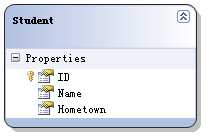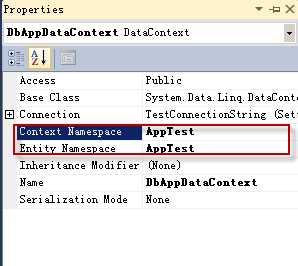标签:
第一篇 从CUD开始,如何使用LINQ to SQL插入、修改、删除数据
准备工作,现在数据库中建好测试表Student,这个表只有三个字段ID,Name,Hometown,其中ID为int类型的自增长字段,Name和Howmtown是nvarchar类型
1. 打开VS2010新建控制台应用程序,然后添加LINQ to SQL Class,命名为DbApp.dbml,新建dbml文件之后,可以打开server explorer,建立数据库连接,并将我们新建的表拖到dbml文件中,结果如下图

2. 可以通过点击dbml文件空白处,按F4显示dbml属性,可以修改Context和生成实体的命名空间

3. 到现在为止VS2010通过工具为我们创建好了数据表对应实体类和数据表操作添,改,删的方法,现在开始实践
1) 添加 Add
|
1
2
3
4
5
6
7
8
9
10
11
12
13
14
15
16
17
18
|
static void Add(){ //添加一个Student Student aStudent = new Student { Name = "张小二", Hometown = "南海观音院" }; Console.WriteLine("----------begin Add a student"); using (DbAppDataContext db = new DbAppDataContext()) { db.Log = Console.Out; db.Students.InsertOnSubmit(aStudent); db.SubmitChanges(); } Console.WriteLine("----------End Add a student");} |
输出的sql语句
|
1
2
3
4
5
6
7
|
INSERT INTO [dbo].[Student]([Name], [Hometown])VALUES (@p0, @p1)SELECT CONVERT(Int,SCOPE_IDENTITY()) AS [value]-- @p0: Input NVarChar (Size = 4000; Prec = 0; Scale = 0) [张小二]-- @p1: Input NVarChar (Size = 4000; Prec = 0; Scale = 0) [南海观音院]-- Context: SqlProvider(Sql2005) Model: AttributedMetaModel Build: 4.0.30319.1 |
2) 使用linq to sql执行Edit 编辑操作
|
1
2
3
4
5
6
7
8
9
10
11
12
13
14
15
16
17
18
19
20
21
22
23
24
25
26
|
private static void Edit(int id){ Console.WriteLine("----------begin edit"); using (DbAppDataContext db = new DbAppDataContext()) { db.Log = Console.Out; //取出student var editStudent = db.Students.SingleOrDefault<Student>(s=>s.ID == id); if (editStudent == null) { Console.WriteLine("id错误"); return; } //修改student的属性 editStudent.Name = "张小三"; editStudent.Hometown = "张家口张家寨张家营"; //执行更新操作 db.SubmitChanges(); } Console.WriteLine("---------end edit Student");} |
输出的sql语句
|
1
2
3
4
5
6
7
8
9
10
11
12
13
14
15
|
SELECT [t0].[ID], [t0].[Name], [t0].[Hometown]FROM [dbo].[Student] AS [t0]WHERE [t0].[ID] = @p0-- @p0: Input Int (Size = -1; Prec = 0; Scale = 0) [6]-- Context: SqlProvider(Sql2005) Model: AttributedMetaModel Build: 4.0.30319.1UPDATE [dbo].[Student]SET [Name] = @p3, [Hometown] = @p4WHERE ([ID] = @p0) AND ([Name] = @p1) AND ([Hometown] = @p2)-- @p0: Input Int (Size = -1; Prec = 0; Scale = 0) [6]-- @p1: Input NVarChar (Size = 4000; Prec = 0; Scale = 0) [张小二]-- @p2: Input NVarChar (Size = 4000; Prec = 0; Scale = 0) [南海观音院]-- @p3: Input NVarChar (Size = 4000; Prec = 0; Scale = 0) [张小三]-- @p4: Input NVarChar (Size = 4000; Prec = 0; Scale = 0) [张家口张家寨张家营]-- Context: SqlProvider(Sql2005) Model: AttributedMetaModel Build: 4.0.30319.1 |
3)使用linq to sql 执行删除操作
执行代码:
|
1
2
3
4
5
6
7
8
9
10
11
12
13
14
15
16
17
18
19
20
21
|
static void Delete(int id){ Console.WriteLine("-----------begin delete a student"); using (DbAppDataContext db = new DbAppDataContext()) { db.Log = Console.Out; //取出student var student = db.Students.SingleOrDefault<Student>(s => s.ID == id); if (student == null) { Console.WriteLine("student is null"); return; } db.Students.DeleteOnSubmit(student); db.SubmitChanges(); } Console.WriteLine("------------end Delete student");} |
生成的sql语句:
|
1
2
3
4
5
6
7
8
9
10
11
12
|
SELECT [t0].[ID], [t0].[Name], [t0].[Hometown]FROM [dbo].[Student] AS [t0]WHERE [t0].[ID] = @p0-- @p0: Input Int (Size = -1; Prec = 0; Scale = 0) [6]-- Context: SqlProvider(Sql2005) Model: AttributedMetaModel Build: 4.0.30319.1DELETE FROM [dbo].[Student] WHERE ([ID] = @p0) AND ([Name] = @p1) AND ([Hometown] = @p2)-- @p0: Input Int (Size = -1; Prec = 0; Scale = 0) [6]-- @p1: Input NVarChar (Size = 4000; Prec = 0; Scale = 0) [张小三]-- @p2: Input NVarChar (Size = 4000; Prec = 0; Scale = 0) [张家口张家寨张家营]-- Context: SqlProvider(Sql2005) Model: AttributedMetaModel Build: 4.0.30319.1 |
总结:通过以上实践可以看到使用linq to sql执行增改删操作,非常方便,我们甚至不需要学习任何sql相关的知识。
我有两点疑惑,请各位指点:
1. 是否是在执行update和delete时必须先获得实体,然后才能执行操作,我尝试在update时,不去数据库中获取实体,而是自己声明一个实体,然后去删除,但是失败了
2. 在生成的update和delete的条件语句中包含name=@p和hometown=@p的语句,按理说link to sql已经知道id是唯一的主键,为什么还会传这些没有的条件进去的
LINQ to SQL 系列 如何使用LINQ to SQL插入、修改、删除数据
标签:
原文地址:http://www.cnblogs.com/hbsfgl/p/4936515.html